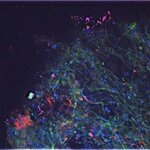Scientists say they have discovered the trigger that pulls together X chromosomes in female cells at a crucial stage of embryo development. Their discovery could also provide new insights into how other similar chromosomes spontaneously recognize each other and are bound together at key parts of analogous cell processes. This is an important mechanism as the binding togetgher of too many of too few of a particular chromosome can cause a number of medical conditions such as Down's Syndrome or Turner's Syndrome.
In our cells most genes are expressed from both types of each chromosome linked…
Microbiology

Deep inside the Frasassi cave system in Italy and more than 1,600 feet below the Earth's surface, divers found filamentous ropes of microbes growing in the cold water, according to a team of Penn State researchers.
The Frasassi cave system is located north of Rome and south of Venice in the Marche region. These limestone caves are like New Mexico's Carlsbad Caverns and Lechuguilla Cave, but in those caves, sulfur entered the caves from oil and gas reserves, while in Italy, the sulfur source is a thick gypsum layer below. Having sulfur in the environment allows sulfur-using organisms to…

Scientists from Imperial College London and the University of Edinburgh say they have shown that tiny crystals found inside bacteria provide a magnetic compass to help them navigate through sediment to find the best food and it provides fresh clues to explain biomagnetism – a phenomenon in which some birds, insects and marine life navigate using the magnetic field that encompasses the Earth.
Researchers say their study, published in the Journal of the Royal Society Interface, focuses on magnetotactic bacteria, which contain chains of magnetic crystals, called magnetosomes. They exist all…

Meiosis, the process of halving a germ cell’s chromosomes in preparation for egg or sperm production, has been one of the most studied areas of cell biology. But in mammals, the field has been divided over the question of whether meiosis is triggered by a signal within a cell or by a signal coming from the cell’s environment.
Now new research from the lab of Whitehead Director David Page reveals that both sets of signals are needed to initiate meiosis.
In 2006,the Page lab showed that an external signal of retinoic acid (RA), a derivative of vitamin A, starts the expression of the Stra8…

A team of scientists from the University of Cambridge and the University of Cukurova in Turkey have taken a major step to understanding how the brain controls the onset of puberty.
The research, published in this week's Nature Genetics, identified the hormone Neurokinin B as a critical part of the control system that switches on the master regulator of human puberty. Although Neurokinin B was previously known to be present in the hypothalamus, the part of the brain that controls puberty, its key role was not previously appreciated.
The identification of Neurokin B could lead to new…

Every living thing is composed of cells and, via receptor proteins on their outer surface, cells communicate with each other and with the outside world. Receptors are found on skin cells (pain and pressure receptors, for example) as well as on the cells of other tissues and organs.
By binding with certain substances, such as hormones, the receptors pick up signals from outside the cell, then they transmit the signal to the interior of the cell where it can induce all kinds of reactions. Receptors can be stimulated or blocked to evoke or prevent a certain effect. Foreign substances, such as…

For the first time in Australia, scientists at Sydney's Centenary Institute have filmed an immune cell becoming infected by a parasite and followed the infection as it begins to spread throughout the body.
Professor Wolfgang Weninger, head of the Immune Imaging program at the Centenary Institute, says the discovery was made possible using high powered multi-photon microscopy which allows real cells to be viewed in real time.
"Using multi-photon microscopy, we studied dendritic cells in the skin. Under normal conditions we found the cells in the epidermis (top layer) were static,…

Scientists at the Swedish medical university Karolinska Institutet have determined the first 3D structure of ZP3, a protein essential for the interaction between the mammalian egg coat and sperm. The findings, presented in Nature, gives a first glimpse into the molecular architecture of animal egg coats, with important implications for the future of human reproductive medicine and the possibility of developing novel contraceptives.
The beginning of every new life starts with fertilization, the most crucial step of which is the initial species-specific recognition between egg and sperm. The…

Bone growth is controlled in the gut through serotonin, the same naturally present chemical used by the brain to influence mood, appetite and sleep, according to a new discovery from researchers at Columbia University Medical Center. Until now, the skeleton was thought to control bone growth, and serotonin was primarily known as a neurotransmitter acting in the brain. This new insight could transform how osteoporosis is treated in the future by giving doctors a way to increase bone mass, not just slow its loss. Findings are reported in the Nov. 26, 2008 issue of Cell.
Researchers have known…

University of Alberta research has yielded a way to double the output of rice crops in some of the world's poorest, most distressed areas.
Jerome Bernier, a PhD student in the U of A Department of Agricultural, Food and Nutritional Science, has found a group of genes in rice that enables a yield of up to 100 per cent more in severe drought conditions.
The discovery marks the first time this group of genes in rice has been identified, and could potentially bring relief to farmers in countries like India and Thailand, where rice crops are regularly faced with drought. Rice is the number…